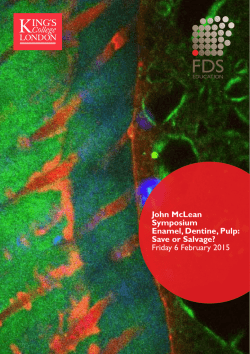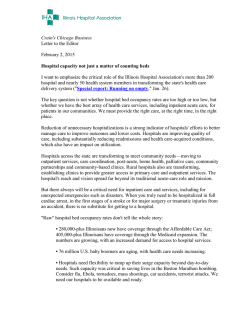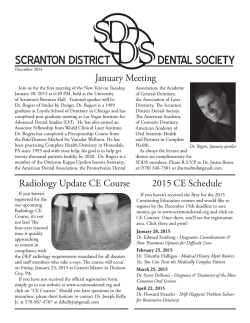
Welcome to Örebro County Council
Welcome to Örebro County Council 1 Where to find us Finland Norway Denmark Sweden Örebro County is situated in the centre of Sweden. Örebro lies between Stockholm, the capital of Sweden (200 km away) and the major city of Gothenburg (300 km away). Facts and figures Number of inhabitants in Örebro County: 275,000 Area of Örebro County: 9,301 square km Area of Sweden: 450,000 square km Örebro County is made up of 12 municipalities. Örebro County Council is represented and works in all 12. 2 Örebro County Council Örebro County Council works to develop the county and improve the quality of life of all its residents. This is to be achieved in the areas of health care, dental care, research, culture, education and regional growth. The Council’s principal responsibility is to organise and provide health care. The County Council’s vision: Örebro County Council will bring about health and vitality through security, quality and sustainable development. 3 The Council’s principal responsibility is health care Good health care – a universal right Medical advances Swedish health services strive to achieve good health and medical care on equal terms for the entire population. All county inhabitants are entitled to expect good health care that meets their specific needs and is readily available, and to receive appropriate and respectful treatment. For us at the County Council, this means that we are to provide good health care and other services to everyone, irrespective of their location in the county. Medical advances lead to shorter waiting times and enable the treatment of increasingly elderly patients. Technological developments mean that many operations are less problematic than in the past, allowing patients to leave hospital earlier. More effective medication enables people to be treated at home rather than in hospital. Working together for an optimal whole Boosting health, curing diseases or improving quality of life often involves a chain of events and other players besides the County Council. To ensure that county residents do not “slip through the gaps”, we at the County Council liaise with municipalities, social insurance offices and others to optimise the efficiency of the whole process. Greater accessibility The Council is working hard to increase access to health services in order to meet patient demands for shorter waiting times. This is being achieved through specific measures in various health care operations as well as through cooperation with other providers. Who does what in Sweden? care, support and help to the disabled, some education and culture. The Council also helps finance various companies and foundations such as Länstrafiken i Örebro AB (public transport), the County Theatre, and Länsmusiken (which is responsible for Örebro Concert Hall, the Swedish Chamber Orchestra in Örebro and other music associations). Örebro County Council and the county’s 12 municipalities work together in a regional association. The County Council should not be confused with the County Administrative Board, which is national government activity at regional level. The executive of the County Administrative Board is made up of the governmentappointed County Governor and representatives appointed by the County Council. Sweden is a democracy, which means that everyone has equal value and rights. In a democracy, everyone is able to influence decisions; as the Swedish Constitution puts it, all public power stems from the people. National level: Parliament and Government The Swedish Riksdag (parliament) is the principal popular representative body. It has 349 members, elected by Swedes in parliamentary elections every four years. The parties that form a majority in the Riksdag appoint a government. The Riksdag makes decisions that affect the whole of society, and interacts with other tiers of the public sector such as county councils and municipalities. The Riksdag also determines the fundamental framework of health care. The overall objective of the Swedish Health and Medical Services Act is to ensure good health and health care on equal terms for the entire population. Swedish health care is decentralised, with the County Councils playing a key role. Health care is largely financed through taxes. The County Councils are responsible for planning all health care in their county, for providing health care, financing privately-run health care and for levying taxes on county residents. The County Councils cooperate at national level in the Swedish Association of Local Authorities and Regions. They work together in six health care regions to provide highly specialised care. They also have cost responsibility for drugs. Apoteket AB is the state-owned chain of pharmacies that has a monopoly on the sale of drugs throughout Sweden. At local level: municipalities Sweden is divided into 290 municipalities led by directly elected politicians elected by the municipality’s residents every four years. Each municipality is responsible for providing its inhabitants with nurseries, schools, care and services for the elderly and the disabled, housing, water and sewage, road maintenance, waste disposal and other amenities. Örebro County contains 12 municipalities. ’’The market’’ Democratically elected bodies at national, municipal and county level are not alone in being able to exercise power and influence. Other entities such as “the market”, the mass media and the courts also wield considerable power. The market impacts on the country’s economy; private sector growth has a major impact on employment, which in turn affects tax revenue at national, county and municipal levels. The media play a part in steering the development of society by influencing public opinion and as purveyors of news and information. Judicial power is exerted by independent courts of law. Regional level: County Councils Sweden has 21 County Councils, led by politicians who are directly elected in general elections every four years. County Councils are the only popularly elected regional parliamentary bodies. Örebro County Council is responsible for health care, dental 4 Health care guarantee Freedom of choice Patients with urgent conditions are always treated directly. Planned operations or treatments are subject to a guarantee for maximum waiting times that applies throughout Sweden. The guarantee states the number of days within which the patient is to be offered planned medical care. The number of days varies, depending on the treatment that the patient needs, but nobody should need to wait more than three months for a planned operation or treatment. If the County Council cannot manage this, the patient is offered the treatment by another care provider. Residents of Örebro County can choose any care provider in the county or elsewhere in Sweden. This freedom of choice does not apply to highly specialised care such as heart surgery and transplants. Cost ceiling and free care for under-20s In Örebro County, health care is free to all under-20s; others pay a patient fee. There are three types of cost ceiling to ensure that nobody incurs prohibitive costs for health care. These are for health care appointments, for patient transport and for medication. Örebro County Council’s main task is to provide the county’s 275,000 residents with health care. About 1,900 people visit a doctor in Örebro County each day. Some 1,000 patients a day are cared for at one or other of the county’s hospitals. The County Council employs roughly 8,700 people whose task is to ensure the health and security of county residents. 5 First tier: Local primary care centres Local primary care centres are the bedrock of Swedish health care. These centres treat 90 per cent of all illnesses and injuries. If necessary, the doctor will refer a patient to a specialist at the county’s hospitals. About 1,900 people in Örebro County visit a doctor on any given day. The vast majority of patients see doctors at their primary care centres. These doctors are specialists in general medicine and are experienced in dealing with most conditions. Doctors, district nurses, child health care, midwives and physiotherapy are available at primary care centres. Patients can also see a social worker or psychologist. In addition there are special youth family planning clinics where teenagers can get advice and help. Örebro County has 29 primary care centres, four of which are run by sub-contractors. Each municipality has at least one primary care centre. People who fall ill during an evening or weekend can turn to the primary care centre’s on-call and telephone advisory services. Round-the-clock health care advice The health care advisory service Sjukvårdsrådgivningen is a supplement to the primary care centre, and serves the entire county. People can call the service 24 hours a day, 7 days a week. Experienced district nurses take the calls and provide medical information and advice about selfcare. They also assess whether the patient needs to contact a doctor. 6 Second tier: County health care at our hospitals Specialist care, such as surgery or treatment, is provided at hospitals. County health care services are also responsible for providing support and help to the mentally ill. Örebro County has three hospitals. The largest is Örebro University Hospital (USÖ), with 37 clinics, 590 beds and 3,500 employees. Karlskoga Hospital in the west of the county has 6 clinics, 150 beds and 900 employees. Lindesberg Hospital, in the north of the county, has 5 clinics, 100 beds and 700 employees. All three hospitals have accident and emergency departments that are open 24 hours a day. The hospitals in Karlskoga and Lindesberg primarily provide specialist care to residents in their catchment areas, but they work together with USÖ in various ways. Karlskoga Hospital cooperates with health care services in Värmland County and also treats patients from Värmland. Ambulance care is an important part of the health care chain. Skilled ambulance staff often start treatment at the scene, thus saving lives. Örebro County Council has long focused on having highly qualified ambulance staff, and each ambulance must be staffed by at least one nurse. The roof of USÖ has a helipad for patients who need to be transported to the hospital especially quickly, due to urgent illnesses or injuries. 7 Third tier: Highly specialised care at USÖ Patients with complicated or rare diseases or injuries receive highly specialised care. Hospitals that provide such care are also centres of research and medical training. Örebro University Hospital – USÖ – is one of eight University hospitals in Sweden and a centre for highly specialised care. USÖ has an impressive track record of success in cardiology, cancer therapy and eye treatments. Most of USÖ’s clinics work with highly specialised care, but the hospital also provides second-tier specialist care to county residents. Highly specialised care is provided to patients from large areas of central Sweden and the rest of the country, as well as patients from Örebro County. USÖ trains doctors from the Department of Medicine at Linköping University. Each year, 60–70 medical students do part of their training at USÖ. The County Council works with Örebro University in the field of medical sciences, and are currently jointly working on the establishment of a comprehensive medical degree course in Örebro. USÖ’s medical device projects attract widespread attention throughout Sweden. One such project is the development of digital imaging technology, which is also linked to a system between the different hospitals. Research in Örebro County Council Örebro County Council is working hard alongside Örebro University to build up the field of medical sciences. We are concentrating on establishing scientific expertise with the main focus on clinical point-of-care research. A number of research groups are studying different types of ill-health, spanning the field from stress and burn-out to modern genetics, and common diseases such as diabetes and cancer. The clinical research centre at USÖ is a hub of education, research and health care evaluation. Örebro County Council earmarks about SEK 100 million a year for research; part of this is financed through various funds. 8 What else do the health services do? Lifestyle and health promotion work Care of the elderly – cooperation between the County Council and municipalities is crucial Lifestyle – our habits regarding diet, exercise, stress, sleep, tobacco and alcohol – has a significant impact on our wellbeing. With the right support we can make wiser choices and stay healthy for most of our lives. This is why the County Council is focusing on maternity care, paediatric care, stop-smoking groups, and weight loss and exercise groups. The County Council also provides financial assistance to sports and exercise activities that contribute to better health in the county. This health promotion work aims to give people the basis they need to make sound choices. The County Council is working to eradicate differences in health based on gender, class and ethnic origin. Most emphasis is placed on children and young people, the elderly and people with psychiatric conditions. The County Council wants to enable detection of disease at an early stage through regular health checks. Mammography and smear tests help in the early detection and cure of many cases of cancer. An increasingly elderly population requires more health care and nursing. Responsibility for provision of good health care to the elderly is shared by the county’s municipalities and the County Council. Municipal nurses and occupational therapists and County Council doctors and physiotherapists at primary care centres are responsible for different treatment measures. The County Council provides health care at primary care centres and hospitals, and each of the county’s three hospitals has a geriatric clinic for treatment and rehabilitation. Home care enables people with prolonged illnesses to receive care in their own home. This care is given by nurses, occupational therapists and other care staff employed by the municipality, as well as doctors and physiotherapists employed by the County Council. Palliative care is a joint effort involving doctors at primary care centres and municipal nurses and care staff. 9 Psychiatry Services for the disabled Psychiatry is part of the County Council’s specialist health care, with the task of examining and treating the mentally ill. Primary care services are responsible for initial care of patients with mental health problems. If the problems become very severe, the patient is referred to the County Council’s specialist psychiatric services. Most psychiatry is provided as outpatient and primary care, but County Council psychiatric services also include 150 inpatient beds. Besides general psychiatry, Örebro County Council’s services have psychiatric units for children and young people, addiction problems, forensic psychiatry and psychosis care. There are also teams working on special areas such as crisis and trauma clinics and teams for the deaf and hearing impaired. People with brain damage, learning difficulties or who for other reasons have difficulty in coping with everyday life are to be able to live as normally as possible. Services to the disabled are provided by municipalities and the County Council. Municipalities give support in day-today living and the County Council provides health care and treatment. The most important task of Council-run habilitation activities is to make life easier for people with disabilities. Assistive technology for people with disabilities The Council supplies assistive technology for people with physical disabilities, learning difficulties and various communication difficulties such as blindness or impaired vision, deafness or hearing impairments. The Council also runs an interpretation centre for the deaf, adult deaf and deaf-blind. 10 largest dental training clinics. Folktandvården has a dental laboratory in the same building. Dental care is free for children and young people under 20. The County Council pays for all dental care for children, including specialist treatment, irrespective of whether the child, parent or guardian chooses a private dentist or Folktandvården. From the year when patients turn 20, they must pay for a large proportion of their dental care themselves. Patients are covered by national dental insurance, which means that the Social Insurance Agency pays some of the cost of dental care. The County Council is responsible for outreach activities to certain care-intensive groups such as the elderly and the disabled. The visits take place in the patients’ own homes. Most of these patients receive necessary dental care according to the same fee system that applies to the County Council’s health care services. The Council finances dental care in the same way for a number of other patient groups with special needs. Dental care for everyone in the county The County Council is responsible for the dental health of the population and for the provision of good needsbased dental care. Patients can choose Council-run dental care or private dentists. About 95 per cent of children and young people up to 19 years old, and some 40 per cent of the county’s adult population, choose Council-run dental care, Folktandvården. Folktandvården is the collective name of the County Council’s dental clinics. Most of their work is general dental care, i.e. ordinary dental care for children, young people and adults. There are 23 clinics in Örebro County. Folktandvården also provides specialist dental care at hospitals. These services offer more complicated treatments. Folktandvården’s centre for specialist dental care includes all types of specialist dentistry. Patients referred to the centre might have serious periodontal diseases, require tooth implants or orthodontic treatment, or be children in need of some form of specialist dental treatment. The centre is also home to one of Sweden’s 11 The County Council: a democratically-governed body The County Council Assembly is the County Council’s highest decision-making body, and is the only popularlyelected county-level parliamentary body. Every four years, the county’s inhabitants elect 71 members of different political parties to the County Council Assembly. The politicians come from all over the county. Their task is to represent the county’s inhabitants. comprises 15 members elected by the County Council Assembly. The members come from the political majority as well as from the opposition. Preparatory committees identify needs The basis of the political organisation is made up of preparatory committees that survey the population’s needs and requests, and propose changes from a citizen’s perspective. The committees work in various parts of the county to make it easy for inhabitants to interact with politicians. The needs of the population are paramount Örebro County Council exists to serve the county’s inhabitants, and their needs are to guide Council planning. The politicians must also ensure that Council activities are run so efficiently that taxpayers’ money is used appropriately. Specialist boards weigh proposals The preparatory committees’ proposals are then brought to two specialist boards for decision. Health care issues are processed by the Health Care Board, while the Research Board deals with research issues. County Council Assembly Each year, the County Council Assembly decides how much county tax county residents will pay. The Assembly sets economic frameworks and guidelines for the County Council’s activities and adopts the budget. The Assembly holds six meetings a year, which are open to the public. The vast majority of those elected to the Assembly are politicians in their spare time; only a few are salaried full-time or part-time politicians. Preparatory work and contact with citizens Between County Council Assembly meetings, many politicians meet in various working groups. This is where all issues are prepared for later decisions. As a democratic organisation, the County Council complies with the Swedish principle of public access. This means that citizens are entitled to see public documentation and keep themselves informed of the County Council’s activities. All county inhabitants can also submit citizens’ proposals to the County Council Assembly. Citizens’ proposals are prepared and processed in the same way as proposals from elected members. The County Council Executive Board leads The County Council Executive Board leads and coordinates Council activities. All issues raised by the County Council Assembly have first been processed by the County Council Executive Board. The Board 12 Örebro County Council´s political organisation as from 2007 The Örebro County Council Assembly has 71 seats. Distribution of seats for 2007–2010: Social Democratic Party (s) 31 seats Moderate Party (m) 13 seats Christian Democrats (kd) 6 seats Centre Party (c) 5 seats Liberal Party (fp) 5 seats Left Party (v) 5 seats Green Party (mp) 3 seats Sweden Democrats (sd) 3 seats 13 County Council administrative organisation Örebro County Council´s administrative organisation 2007–2010 Politicians decide which goals the County Council will work towards and how the money is to be distributed between different areas. A great deal of the work however is governed by legislation such as the Swedish Health and Medical Services Act. The practical work of leading the County Council’s activities and complying with legislation and decisions is a task for the civil service (administrative) organisation and senior County Council staff. The County Council Director leads the administrative organisation with its 8,700 employees. This is the highest civil service position in the County Council. 14 SEK 6 billion to run the County Council Eighty-six per cent is spent on health care Örebro County Council’s activities cost about SEK 6 billion a year to run. This is mainly funded through taxes paid by the county’s inhabitants. An average wage earner pays about SEK 2,000 a month in tax to the County Council. Thanks to that money, the Council can provide good health care to all, free health and dental care to children and young people, habilitation for people with disabilities, education, support for culture, and generally safeguard of the interests of county inhabitants. Health care is the County Council’s largest area of operation. It accounts for more than 86 per cent of the Council’s costs. More than half of the County Council’s costs are salaries. With 8,700 employees, the County Council is one of the county’s biggest employers. 15 A typical day in Örebro County Seven babies are born, and nine people die. Ambulances make 64 call-outs. 1,000 patients are cared for at the county’s three hospitals. About 1,900 people go to a doctor somewhere in the county. Health care costs SEK 12.8 million. About 4,700 people are at work in Council-run health care services. Box 1613, SE-701 16 Örebro, Sweden Tel. (switchboard): +46 19-602 70 00 E-mail: [email protected] www.orebroll.se 16 Production: Tammerman/Koubek. Photos: Magnus Wahman, Magnus Westerborn and Weine Ahlstrand. Printing: Tetab Tryckeri AB. 2008 70 patients undergo surgery in the county’s hospitals.
© Copyright 2024





